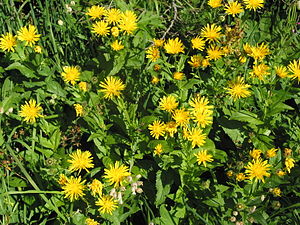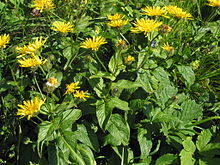Cockwort Pippau
| Cockwort Pippau | ||||||||||||
|---|---|---|---|---|---|---|---|---|---|---|---|---|

Cockwort Pippau ( Crepis pyrenaica ) |
||||||||||||
| Systematics | ||||||||||||
|
||||||||||||
| Scientific name | ||||||||||||
| Crepis pyrenaica | ||||||||||||
| ( L. ) Greuter |
The scraping Herb Pippau ( Crepis pyrenaica ), also Pyrenean Pippau called, is a plant from the genus Pippau ( Crepis ) within the family of Compositae (Asteraceae).
description
Vegetative characteristics
The cockwort Pippau is a deciduous, perennial herbaceous plant and reaches heights of (4 to) mostly 25 to 70 cm. A crooked, cylindrical, blackish rhizome is formed. The upright stem and quite densely leafed to the tip, simple or usually a little branched at the tip. The stem is bald or stiff to the top, almost shaggy.
The leaves are broadly ovate or ovate-lanceolate, pointed, toothed and lightly haired. The basal leaves are 5 to 17 cm long and 1 to 2.5 cm wide and narrowed into a winged stem, but already dead at the time of flowering, the upper ones with an arrow-shaped base that encompasses the stalk with pointed ears.
Generative characteristics
The flowering period is between June and August. One specimen has one and a few (two to six) cup-shaped inflorescences that are (2 to) 3 to 4 cm in diameter. Your envelope (involucre) is 12 to 18 mm long and 10 to 18 mm wide, rolled and blackish-green. All bracts are about the same length. The outer bracts are less hairy, the inner shaggy with a series of long, green, black or yellowish, stiff hairs ( trichomes ), but without glandular hairs. The flower heads contain only ray florets . The ray-florets are golden yellow and about twice as long as the envelope. The styles are yellow.
The yellow-brown achenes are spindle-shaped with a length of 6 to 8 mm and have about 20 ribs. The pappus is pure white.
The cockwort Pippau is diploid with a chromosome number of 2n = 8.
Taxonomy
In 1753, Carl von Linné published in Species Plantarum two names ( Basionyme ) pertaining to the cockwort Pippau at the same time and on the same page : Hieracium pyrenaicum L. and Hieracium Blattarioides L. In 1767 he decided on the priority of Hieracium pyrenaicum by choosing Hieracium Blattarioides as a variety Hieracium pyrenaicum var. Blattarioides recombined. Belonging to Crepis was recognized by Dominique Villars , who founded the cockwort Pippau in Crepis Blattarioides (L.) Vill. renamed. The German name "Schabenkraut-Pippau" is derived from this name, which was common for a long time. Its subordination was only discovered in 1970 by Werner Greuter , who combined the now accepted name Crepis pyrenaica (L.) Greuter .
Occurrence
The distribution area of the cockwort-Pippau includes the mountains of southern and central Europe from the Pyrenees over the Alps including the Jura , the high altitudes of the Vosges and the Black Forest and the Piedmontese Apennines . It occurs in the following European countries: Spain, Andorra, France, Italy, Switzerland, Germany, Liechtenstein, Austria, Slovenia and Croatia.
The cockwort Pippau thrives on loose, well-ventilated, fresh, nutrient-rich, mostly calcareous, stony or pure loam or clay soils in montane to subalpine altitudes at altitudes between 700 and 2240 meters. In the Allgäu Alps, it rises to an altitude of around 2100 meters. It grows in tall grass corridors (association Calamagrostion arundinaceae) or tall herbaceous corridors (association Adenostylion alliariae), less often in fatty meadows or in green alder bushes.
swell
literature
- Gerhard Wagenitz (Hrsg.): Illustrated flora of Central Europe. Pteridophyta, Spermatophyta . Founded by Gustav Hegi. 2nd revised and expanded edition. Volume VI. Part 4: Angiospermae, Dicotyledones 4 (Compositae 2, Matricaria - Hieracium) . Paul Parey, Berlin / Hamburg 1987, ISBN 3-489-86020-9 , pp. 1141–1142, 1433–1434 (revised reprint of the 1st edition (Volume VI / 2 of 1929) with addendum). (Sections Description, Occurrence, Taxonomy)
- Peter Derek Sell: Crepis pyrenaica In: TG Tutin, VH Heywood, NA Burges, DM Moore, DH Valentine, SM Walters, DA Webb (eds.): Flora Europaea . Volume 4: Plantaginaceae to Compositae (and Rubiaceae) . Cambridge University Press, Cambridge 1976, ISBN 0-521-08717-1 , pp. 349 (English, limited preview in Google Book search).
- David Aeschimann, Konrad Lauber, Daniel Martin Moser, Jean-Paul Theurillat: Flora alpina. An atlas of all 4500 vascular plants in the Alps . Volume 2. Haupt, Bern / Stuttgart / Vienna 2004, ISBN 3-258-06600-0 , pp. 672-673.
Individual evidence
- ↑ a b c d e f g h i j k l Schabenkraut-Pippau. In: FloraWeb.de.
- ↑ Carl von Linné: Species Plantarum. Volume 2, Impensis Laurentii Salvii, Holmiae 1753, p. 804, digitized
- ^ Carl von Linné: Systema Naturae. editio 12, tomus 2: Regnum vegetabile. Impensis Laurentii Salvii, Holmiae 1767, p. 523, PDF file .
- ↑ Dominique Villars: Histoire des plantes de Dauphiné. Tome troisieme. Grenoble, Lyon, Paris 1788, p. 136, PDF file .
- ↑ Werner Greuter: Exsiccatorum Genavensium a Conservatorio Botanico distributorum. Fasciculus primus. Conservatoire Botanique de Genève, Geneva, 1970, p. 15.
- ^ Sandro Pignatti (ed.): Flora d'Italia . Vol. 3. Edagricole, Bologna 2003, ISBN 88-506-2449-2 , pp. 274 (third unaltered reprint of the 1st edition from 1982).
- ↑ Werner Greuter (2006+): Compositae (pro parte majore). - In: W. Greuter & E. von Raab-Straube (eds.): Compositae. Euro + Med Plantbase - the information resource for Euro-Mediterranean plant diversity. Datasheet Crepis pyrenaica In: Euro + Med Plantbase - the information resource for Euro-Mediterranean plant diversity.
- ↑ Erhard Dörr, Wolfgang Lippert : Flora of the Allgäu and its surroundings. Volume 2, IHW, Eching 2004, ISBN 3-930167-61-1 , p. 678.
- ^ Erich Oberdorfer : Plant-sociological excursion flora for Germany and neighboring areas . With the collaboration of Angelika Schwabe and Theo Müller. 8th, heavily revised and expanded edition. Eugen Ulmer, Stuttgart (Hohenheim) 2001, ISBN 3-8001-3131-5 , pp. 992-994 .
Web links
- Cockwort Pippau. In: FloraWeb.de.
- Cockwort Pippau . In: BiolFlor, the database of biological-ecological characteristics of the flora of Germany.
- Profile and distribution map for Bavaria . In: Botanical Information Hub of Bavaria .
- Crepis pyrenaica (L.) Greuter In: Info Flora , the national data and information center for Swiss flora .
- Thomas Meyer: Pippau data sheet with identification key and photos at Flora-de: Flora von Deutschland (old name of the website: Flowers in Swabia )
- Pyrenees-Pippau, cockwort-Pippau. In: Botanik im Bild / Flora of Austria, Liechtenstein and South Tyrol. Natural History Museum Vienna, accessed on March 3, 2012 .


